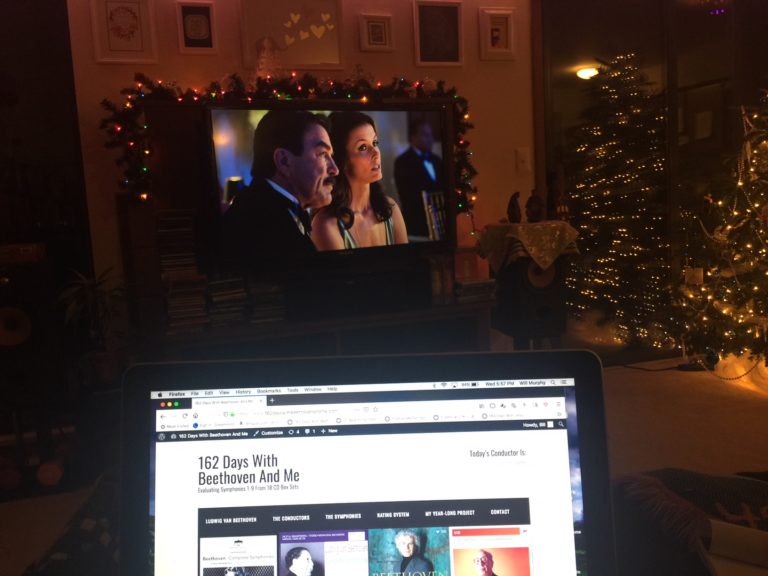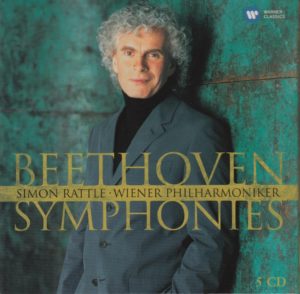
My listening post this evening is in front of the TV, the Christmas tree (sans presents), and with an egg nog laced with Captain Morgan Rum beside me.
On the TV is the series Blue Bloods, starring the one and only Tom Selleck (who will forever be Magnum, P.I to me), as Police Commissioner Frank Reagan. This is Season 2 Episode 1: “Mercy.” Also in the photo is Bridget Moynahan as Erin Reagan. It’s a superb TV series.
Anyway, while Frank Reagan helps break in the new mayor of New York City, I’m listening to English conductor Sir Simon Rattle (1955- ), Wiener Philharmoniker, and Beethoven’s Symphony No. 9 in D minor.
I’ve encountered Maestro Rattle eight times previous to this evening, on…
 Day 15. Rating: “Meh!”
Day 15. Rating: “Meh!”
Day 33. Rating: “Meh!”
Day 51. Rating: “Meh!”
Day 69. Rating: “Meh!”
Day 87. Rating: “Meh!”
Day 105. Rating: “Meh!”
Day 123. Rating: “Meh!”
Day 141. Rating: “Huzzah!”
Seven “Meh!” and one “Huzzah!” ratings.
I remember what I wrote on Day 141 about that “Huzzah!” rating:
One of the biggest-selling albums of all time is Frampton Comes Alive!, the 1976 double-live album by English musician Peter Frampton (1950- ). The album is estimated to have sold over 11 million copies worldwide. (Say, now that I look, Simon Rattle does look a bit like Peter Frampton.)
I mention Frampton Comes Alive! because this performance of Beethoven’s Eighth could be titled Rattle Comes Alive!
For the first time in eight symphonies someone seems to have lit a fire under Maestro Rattles ass.
The orchestra is energetic and passionate!
I remember being totally amazed that Maestro Rattle had the energy to elicit an “Huzzah!” rating from me.
Let’s see how today’s performance goes, and if he has one more “Huzzah!” left in him.
 Beethoven wrote his symphonies in four parts (except for the Sixth, which is in five). The time breakdown of this particular one (Symphony No. 9 in D minor),
Beethoven wrote his symphonies in four parts (except for the Sixth, which is in five). The time breakdown of this particular one (Symphony No. 9 in D minor),
from this particular conductor (Rattle, at 47) and this particular orchestra (Weiner Philharmonker), at this particular time in history (May 12, 14 & 15, 2002) on this particular record label (Warner Classics) is as follows:
I. Allegro ma non troppo, un poco maestoso………………….16:56
II. Molto vivace………………………………………..11:59
III. Adagio molto e cantabile……………………………..17:03
IV. Finale (A)…………………………………………….6:19
IV. Finale (B)…………………………………………….17:40
Total running time: 69:17
My Rating:
Recording quality: 3 (more than usual tape hiss throughout, missing a smidgen of top end; fairly good – but not perfect – balance of instruments represented in the performance)
Overall musicianship: 4 (uneven, passionate at times, rote at others)
CD liner notes: 3 (one essay about Beethoven in English, German, and French; nothing about Rattle)
How does this make me feel: 4 (“Meh!”)
I didn’t like it. And I’m not sure why.
Movement I (the ethereal start to the symphony) didn’t do its job and draw me in. Then, Movement II sounded different to my ears. The timpani was too loud. There seemed to be instruments playing at times I hadn’t heard playing in previous performances. Plus, like Movement I, I wasn’t drawn in, compelled to listen. My mouth wasn’t grinning. My head wasn’t bobbing. My toes weren’t tapping.
Given that neither Movement I nor Movement II blew me away, there was a lot of pressure for Movement III (the slow one that needs a spark of magic to keep my attention). Done right, Movement III can be sublime, even emotional. Don’t poorly and it’s a snooze fest.
Fortunately, this was done right. There were parts of Movement III that lifted it above the norm, that felt magical, and deeply emotional. Bravo!
Movement IV is another one that has to get off the ground fast and fly high – right from the get-go. It has to be, for my anyway, totally engrossing so that when the melodic strains of “Ode to Joy” appear the anticipation is high, which (in this case) is around 2:49.
Later, when the full orchestra comes crashing in echoing the lone viola (or whatever the instrument is at 2:49), it has to feel huge, massive, emotionally pulverizing…and punchy.
Alas, this doesn’t do that.
There’s something about Maestro Rattle’s performances that seems imprecise, like he deson’t instruct the musicians to bite off each note like a native New Yorker bites off each syllable in a sentence. This is especially important during sections that are supposed to be punchy and powerful. In the absence of this “biting” style of playing, all the instruments seem to run together, kind of sloppily.
Then the voices come in and it’s all over for me.
If the first three movements don’t grab me by the time I get to the operatic part, it’s all over for me. My teeth are on edge and my emotional bank account (to use a Stephen R. Covey term) is overdrawn, which means I am no longer willing to invest myself in the music.
I can’t tell what it is about Maestro Rattle’s performances that I don’t grok. They seem subdued, tentative. Maybe it’s because he’s still fairly young (only 63 as of this blog entry). He still has time to grow more confident in himself and let ‘er rip more often than not.
“Meh!”
NOTE: There are only three days left in my 162 Days With Beethoven And Me project! I’m looking forward to the break from writing about Beethoven every day – not that I haven’t enjoyed the hell out of this. I have. It’s that I’d like to use those 2-3 hours per day for other writing projects.
